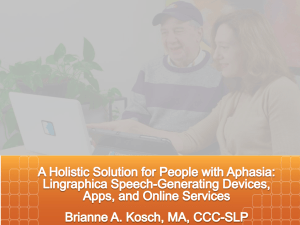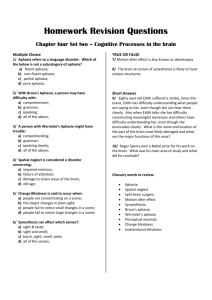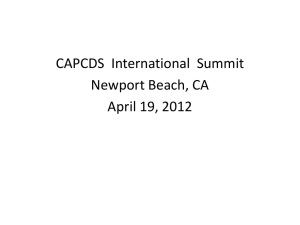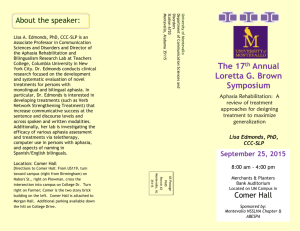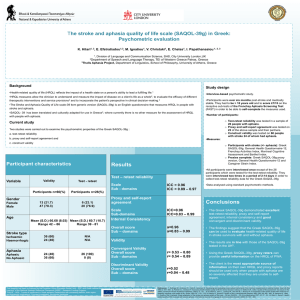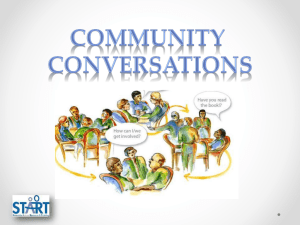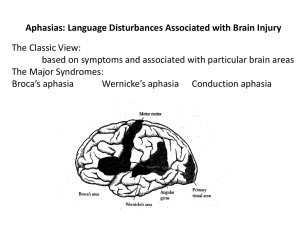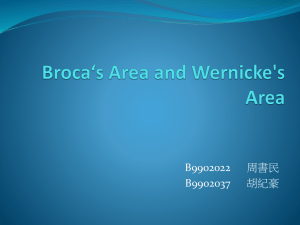Goal Attainment Scaling presentation
advertisement
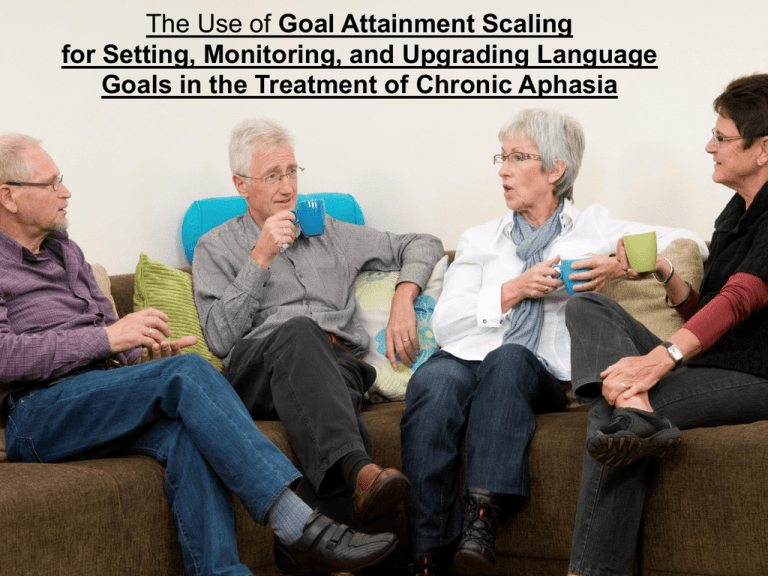
The Use of Goal Attainment Scaling for Setting, Monitoring, and Upgrading Language Goals in the Treatment of Chronic Aphasia Presented by Wendy Duke RSLP, Registered Speech-Language Pathologist, M.Sc., CCC(SLP) Director, Columbia Speech and Language Services, Inc. (CSLSI) and iTAWC ( a speciality clinic of CSLSI) Assistant Clinical Instructor, and Sessional Instructor UBC School of Audiology and Speech Sciences Authored by Wendy Duke, Ramanjit Bains, Alisa Ferdinandi and Lauren Tittley wendy@columbiaspeech.com www.columbiaspeech.com www.itawc.com STATEMENT OF PROBLEM: • Most aphasia assessment batteries focus on categorizing aphasia type (e.g. BDAE-3 and WAB-R), outlining functional difficulties (e.g. CADL-2, ALFA), or identifying psycholinguistic processes affected (e.g. PALPA). • None of these, however, provide a framework to help clinicians to set specific functional goals. • Nor do they help the clinician to easily monitor incremental changes in these functional goals • Nor do they provide the clinician with a framework to advance goals systematically. • And, such tests may lack the sensitivity to measure ongoing “subtle but important changes” (Schlosser, 2004) in functional communication that may occur months or even years post-stroke. What is the right measurement tool for the job? What are we measuring? How should we measure it? What tool should we use to measure it? We believe that GAS is the right tool to • Customize a functional speech or language goal for an individual with chronic aphasia • Measure progress toward the goal systematically • Adjust goals to increase or decrease challenge as the treatment proceeds • Communicate meaningful numeric data to funding sources So….. • What is Goal Attainment Scaling? • Originally developed as a clinical tool in psychiatry, GAS is a numeric scale written around a specific goal, in which the client’s baseline and desired outcomes are defined, and each are assigned a numeric or alphabetic value along a scale • But what does GAS look like? Structure • +2 highest outcome reasonably attainable for client on a given goal • + 1 outcome in which expectations are exceeded by the client on a given goal • 0 expected outcome for client on a given goal • -1 client’s baseline performance on a given goal • -2 decline in client’s performance from baseline • Using a 5-point scale, G.A.S. allows the clinician to set graduated, personalized target outcomes predicated upon the client’s observed baseline and desired outcome. • It can be used for a wide variety of behaviours. My Teenage son’s laundry behaviour • +2 – independently washes, dries and puts away own laundry • + 1 – washes, dries, puts away own laundry with reminder from Mum • 0 - dries, puts away own laundry with reminder from Mum • -1 - only puts laundry in hamper when Mum threatens to donate clothing left on various floors around house • -2 – makes dramatic attempt to load clothing in machine without emptying pockets, “accidentally” includes rocks, gum and weight-lifting chalk, breaks machine in vain hope that Mum will never mention laundry again. • It has been adapted for use for various communication disorders (Schlosser, 2004). History of the use of GAS at our clinic • At ASHA in 1990, I attended a talk on the use of GAS for TBI ( author unknown) • Throughout 1990s and beyond, we used this as a tool for setting collaborative goals and measuring communication behaviours (and as a teaching tool) in a group therapy program for people with TBI (more later if time and interest permits) • In the 2000s, we started using GAS for our chronic aphasia conversation group, and in 2011, we started using it in our intensive program. G.A.S. IN CHRONIC APHASIA TREATMENT: • We applied G.A.S. both within a conversationbased aphasia group and a recovery-focused intensive aphasia treatment program (iTAWC* – Intensive Treatment for Aphasia in Western Canada). Goals were established taking into account the desired outcome expressed by clients, therapist observations, and the expectations of therapists as to realistic, achievable outcomes within a given timeframe. Conversation group • Goal area – Conversation participation, specifically to increase participation of individuals with various levels of aphasia in Monday morning conversation group and measure this. • Funder ( government ) wanted numerical outcome data. • No available measures seemed sufficiently sensitive G.A.S +2 – best expected outcome Goal The client asks the question “How was your weekend?” independently. +1 – more than expected The client asks the question “How was your weekend?” when cued to their turn in the conversation. 0 – expected outcome The client asks the question “How was your weekend?” with the starter prompt “How was your…” -1 – baseline The client repeats the question “How was your weekend?” after clinician model. -2 – regression The client is unable to repeat the question “How was your weekend?” even with maximal cueing. • In the context of the conversation group, all participants shared the same general goal area, but had different baseline and target points on the scale based on individual abilities and needs. The preceding shows results for one client who achieved his expected outcome during one round of treatment and then achieved the next level up in the following round of treatment. Although time consuming to set goals initially, G.A.S. allows for easy adjustment of targeted goals as clients improve. iTAWC • Intensive Treatment for Aphasia in Western Canada • Developed three GAS goals for each client • First example ( of three) is for a man with fluent aphasia, for whom the following GAS is in the goal area of Communication Efficiency G.A.S. Goal +2 – best expected outcome In conversation, client conveys more than 6 distinct and relevant content units per minute. +1 – more than expected In conversation, client conveys 6 distinct and relevant content units per minute. 0 – expected outcome In conversation, client conveys 5 distinct and relevant content units per minute. -1 – baseline In conversation, client conveys 3 distinct and relevant content units per minute. -2 – regression In conversation, client conveys less than 3 distinct and relevant content units per minute. • • • This client surpassed his best expected outcome. For this gentleman with fluent aphasia, the goal of communication efficiency was strongly identified by his family as an important goal. Relevant content words were counted as an indicator of efficiency. This improvement in communication efficiency was not reflected in changes on sections of the WAB-R that measured narrative production, indicating that G.A.S. is a more sensitive marker of functional change in conversation ability. G.A.S. Goal +2 – best expected outcome Client independently reads and comprehends an article of her choice. +1 – more than expected Client independently reads and comprehends a 2 to 3 paragraph passage from an article of her choice. 0 – expected outcome With support (decoding difficult words), client reads and comprehends a 2 to 3 paragraph passage from an article of her choice, e.g. Savage Love. -1 – baseline The client requires support to read and comprehend a single paragraph. -2 – regression The client cannot read and comprehend a single paragraph even with support. • This client achieved her expected outcome in reading for pleasure. • This goal was identified as important by the client who had previously been an avid reader prior to her stroke. Goal area – email composition • Email correspondence was of particular importance to this next woman, who wanted to keep in touch with her husband and young children throughout her month long stay at iTAWC and with extended family when she returned home. G.A.S. Goal +2 – best expected outcome Composed directly on computer, independently, with “email helper” list +1 – more than expected Composed directly on computer, with minimal assistance and with “email helper” list Composed directly on computer, with maximal assistance and with “email helper” list Wrote thoughts on paper first, then typed on computer. 45-60 minutes to compose short email with maximal assistance Wrote thoughts on paper first, then typed on computer. 61+ minutes to compose short email with maximal assistance 0 – expected outcome -1 – baseline -2 – regression • Her “email helper list” consisted of a bank of common phrases and names. • Specific suggestions for how to help her move toward independence with this goal were shared in the exit meeting and in her final report. BENEFITS of G.A.S. • • • • Easily allowed clinicians to determine the next steps in treatment once an expected outcome had been achieved. Facilitates communication with families regarding goals. Facilitates discussion with funding agencies regarding functional progress. Is a sensitive indicator of functional improvement. CHALLENGES of G.A.S. • • Goal-setting is very time consuming. Setting of the expected outcome is best when delayed until a few sessions into treatment, as it is difficult to determine a realistic outcome for a client without first observing their response to therapy. CHALLENGES of G.A.S. cont’d • • Many of our clients surpassed the expected outcome, which is meant to be the most probable and realistic expectation for achievement of a goal, thus indicating that better goal setting is necessary. Schlosser (2004) suggested having an independent rater to determine if a goal is achieved. Due to time, budgetary and other constraints, this was not achievable in our settings. CONCLUSION: • For people with chronic aphasia, Goal Attainment Scaling is a useful clinical tool to allow measurement of functional changes, to monitor progress, and to systematically adjust goals upward as clients progress. • Goal Attainment Scaling measured some functional changes in communication that standardized testing did not capture. REFERENCE Schlosser, R.W. (2004). Goal attainment scaling as a clinical measurement technique in communication disorders: A clinical review. Journal of Communication Disorders, 37, 217239. Disclosure: The author receives financial compensation from Columbia Speech and Language Services, Inc., the clinic in which the programs described are provided Questions? Wendy Duke 604-875-9100 wendyduke@shaw.ca
